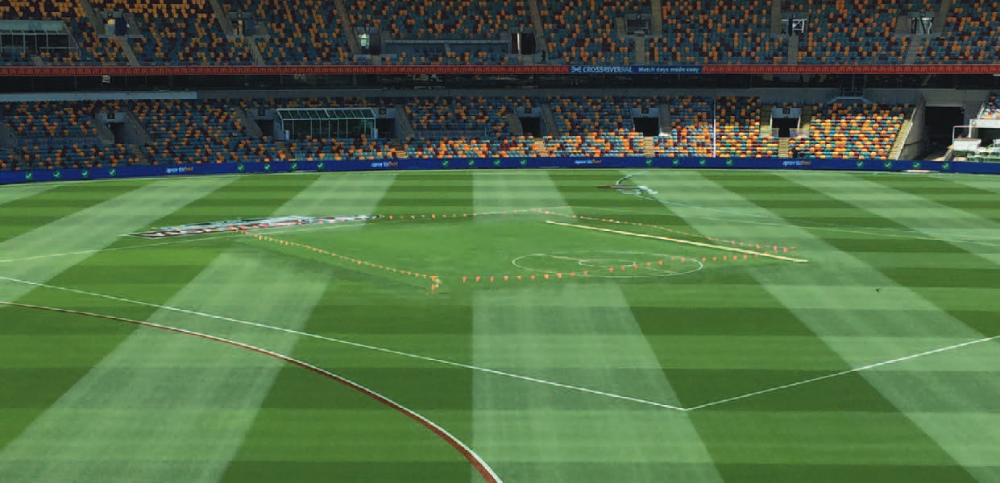Couch Mite Management: A Modern Approach
In the sportsfield situation mites are of concern due to the impacts they confer to health and growth. The foliar distortion that impacts growth habits, and the toxins that create unresponsive swards are specific reasons mite presence and activity trigger prompt responses. Sportsfields have certainly been hit hard during some of the more recent prolonged dry periods. Mites love dry conditions and sites with significant irrigation limitations (especially no overhead watering) are increasingly vulnerable. Successful mite management requires adoption of a range of management options. When one is not possible others simply carry greater importance.
Importantly mites are not insects so from the outset any assumptions we bring across from other insect management needs to be moderated. They are more closely related to spiders, scorpions and ticks. This is partly why our chemical treatment options sometimes seem narrower than they are for other insect pests of turf. Mites are quite insidious as they hurt turf physically as well as chemically, breed rapidly to grow populations when conditions are right, and literally use the turf as a protective barrier against treatments we apply. They have evolved to be an elusive and rather successful pest.

Things do seem to have changed
Precisely what the reason is for the changes we may be seeing in the difficulty to successfully treat mites is unclear, but it does create plenty of debate. So, before we get too far let’s just agree mite management (on some sites, but not all) seems tougher than it used to be. We know over the last 30 years or so we have seen changes in products available, the sophistication of the industry, and the quality of turf surfaces produced. Possibly changes in mite pressure are a product of numerous other changes or improvements we have adopted as part of the evolution of the industry - each contributing a small piece to the puzzle. The lack of some older chemistries that were powerful and broad spectrum does get raised from time to time? Have we picked out the strong performers through a process of selective pressure where the genotypes better suited to what we have thrown at them in the past march on and the susceptible have fallen away? Is it some other environmental factor or reflecting something that changed in our turf management practices where we support them better than before? We could spend a bit of time on this. Bottom line though is its often different, we do need to adapt, and as always a bit of knowledge goes a long way in promoting success.
We are adapting just like the mites we are trying to treat
A number of companies who sell Miticides have helped raise the bar on knowledge and understanding of this pest. This is to be commended. It wasn’t that long ago we were a bit limited in our options, small in number with some of the available candidates sitting high on the schedules. As further products came to market, more were sitting lower in the schedules, more genuinely different products were able to be combined in programs helping address resistance concerns, we could use the high schedule options more sparingly, and more information on the optimal use of products was coming along with each registration. We improved our understanding of lifecycle biology, enhanced our knowledge on matching this biology to the chemistries available, and got far better at understanding the application processes that get the most from each. So, it’s important we acknowledge our progress, but equally important (for the benefit of all) to recap some of this as we edge closer to the time of year we may be dealing with them again.
Mites are the perfect candidates for resistance management models – or atleast as models for communicating what a high risk profile looks like. They tick all the necessary boxes to make red lights flash and sirens sound. Rapid generational turnover, massive generational population numbers, responsiveness for breeding when conditions are right, a history of being managed with limited chemical options and an equally limited history in regards to local investigations that fully characterize the true situation. Whilst this is also acknowledged, continuing to look backwards will not advance our cause. Taking everything we know, and using every tool available in future, is where the opportunity sits.
Looking at this spring - what’s the plan?
So where do we sit? We have more registered tools available than prior years, we have products from distinctly different chemistry classes that represent true MOA rotation opportunities, we are able to target the pest to kill as well as interfere with breeding potentials, and we are better able to support this with targeted cultural practices to work in concert with those chemistries. Are we in an ideal situation? Fair to say no. Do we have tools that can improve the situation? Fair to say yes.
What does this look like? Our major active ingredients registered for mites are pyrethroids (e.g. bifenthrin, beta-cyfluthrin), avermectins (e.g abamectin), pro insecticides such as difenthiuron, and growth regulators (e.g. etoxazole and clofentazine). For chemical strategies these are the tools we work mostly with today so they are the focus here. In terms of sequence and timing there is a clear logic that matches chemistry characteristics to function and lifecycle.
It has been well characterized the mites we find in our turf can have generations that turn in as little as 10—14 days when conditions are right. So thinking in terms of those time blocks we see a sequence commonly recommended that ensures chemistries are alternated in conjunction with lifecycles looking to avoid situations where multiple sequential generations all see the same chemistry. The rapid breeding has the further effect of accelerating the selection of resistant individuals if singular or narrow based chemistries are applied hence the principle of rotation is front and centre.
Commonly it will be suggested step 1 is either a growth regulator, or a growth regulator (IGR) applied with an adulticide. The IGR piece needs to be re-iterated here – it should lead a program in applications against active adults as it interferes with an adults ability to breed further. Why is this point being laboured? Because often the first adulticide suggested is abamectin and this product has been given a pretty reasonable run historically. It still has a strong role to play but it needs some protection and help. If any element of a population proves less susceptible to abamectin than we had hoped we should try to cover this with the IGR that alternatively can suppress or prevent further breeding if it slips through. If both miss for any reason, a further backup should follow. This is redundancy planning on redundancy planning if you follow.
That back up is usually an alternate chemistry, from entirely different class and MOA family. Diafenthiuron gets the nod here and it’s a strong performer with a proven history as a miticide in big world-wide crops. It’s a pro-insecticide meaning a chemical transformation needs to occur between the molecule in the bottle to what can actually treat the target. You don’t need to do anything to make this happen – other than apply it properly. The chemical change occurs either in the environment or in the host independent of anything the applicator does so don’t get too caught up in this. It is simply communicated because the transition can take time. An application made today may be reviewed tomorrow or a couple of days later with mite activity still noted on the turf. The product may take a day or two to ‘warm up’ but it will so have confidence. The impacts on the mites should be seen thereafter. The allowance for this transition phase is partly why we should also assume a window of activity that is a bit longer than the initial adulticide window.
For any site troubled by mites there is a very good chance that even if you get this far into a control schedule you will still need to go further. Chances are a mite management program started late spring or even early summer and this run through would only have got you 6-8 weeks in. Be prepared to repeat it again as those that slipped through probably have an environment suiting them even better now than it did before. If first time round it was IGR + abamectin leading the exercise before the follow up with difenthiuron, then second time round consider switching the abamectin for an SP. Let’s look after abamectin a bit, get an alternate MOA chemistry in the schedule that itself should still have a good impact, and if by chance you need a third run maybe come back to abamectin again then.
We mentioned cultural practices – where do they fit? They fit hand in glove with chemical approaches. Mites enjoy healthy turf but absolutely smash turf already under pressure. When we have had dry late winters and springs then summer populations flourish and turf under pressure seems to be hit harder courtesy of the set backs they already suffered leading in. Soft succulent turf equally becomes vulnerable due to the luxuriant nature of the food source so juicing the turf up is not necessarily the answer. The role of water shouldn’t be under-estimated though. Drought stressed turf has little ability to tolerate a mite infestation and damage can appear magnified. Sufficient water is a basic necessity to maintain adequate health. However, if water is available it can be used to modify the mite environment – they don’t like it much. Many times a clear definition of damage on a fairway or surround will be seen to match the tide marks of surface water after a storm. Water is a precious resource but if available and used as overhead irrigation – this can form part of a broader mite management approach representing part of the non-chemical component.

Nutrition is also important on three fronts. Firstly, to maintain a base level of health and vigour to sustain the turf itself, but then secondly also to maintain a growth rate that can defend and counter small amounts of damage if it does occur. Finally, and arguably just as important, using nitrogen technologies that meter nitrogen as opposed to dump it in volumes helps build stronger foliage as opposed to luxuriant soft foliage. This helps manage disease as well as the mites so thoughtful practice helps you win twice.
General hygiene is one further area deserving attention. Simple things like disposing of clippings that likely contain active mites well away from the turf under culture is a simple – yet valuable non-chemical measure. Recognising signs of stressed turf, lifting cutting heights if possible, and not bringing machinery from other sites onto your turf (again if possible) helps limit the physical movement of mites themselves and debris that can harbor them.

How Nuturf can help you
Mite management is an area we as an industry have certainly improved. Problem is we have a pest that is rather flexible and responsive to change as well and has proven itself a formidable opponent. When the challenge is high you turn to partners with the knowledge and the experience.
Nuturf have a highly experienced territory management team who have seen the changes in mite pressure, and have participated in the evolution of the registered options and agronomic practice in response. Nuturf have access to, and work closely with, the manufacturers developing new tools so can help you understand the differences, the opportunities and the best practices.









